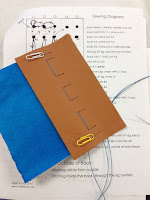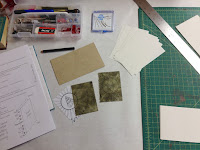I spent a week at the
John C. Campbell Folk School taking an amazing book arts class: Books of the Earth.
Holly Fouts was the instructor and Cheryl Prose was the assistant. The focus was using natural materials to make artful books with variations of the historic long stitch binding. We worked with mica, natural dyes, wax, rusting and burning to create interesting pages for mica, copper or brass covered books.
We experimented with several tea, coffee and
walnut dyes on a variety of paper types. The berry tea dye changed color, depending on the acidity of the paper it remained red or turned green. I used this dye on the pages for my first mica book. I dyed all the pages of the second mica book using a walnut dye. I used crumpled waxed paper both under and on top of the dyed paper to create additional texture. The finished paper needed to be ironed and pressed before being stitched to the book spine.
We used small culinary butane torches to heat copper and brass to create colored patterns on the surfaces. Heat treating metal alters their physical properties. This is usually done to improve the strength or elasticity of the material (
annealing and tempering). It will also change the color of the material. This process required careful heat control. If the metal is over heated all the color is lost. The trick is to stop heating as soon as the metal starts to develop the color you want, since the metal will continue to change color after the heat is removed. I plan on using the copper and brass mesh as part of future art book covers.
We used a variety of rusty iron, copper and brass items to create
rust patterns on different types of paper. Vinegar is used to
promote rust and transfer it to the paper. We also experimented with wood burning tools and candles to carefully discolor, scorch, char and burn paper.










